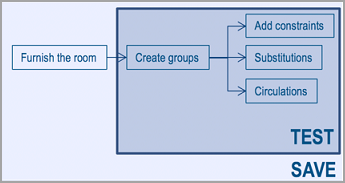Introduction to Templates
Getting Started
The Concept of Template
Templates automatically propose to users a typical arrangement of products. The application automatically fits those
arrangements to the room size and shape defined by the user.
Those arrangements and their scalable behaviors are defined by Range Maintainers as templates. They include products
from the product catalogs of their Legal Entity. Templates are published to application distributions through template
catalogs.
In order to create a template, Range Managers need to:
- Create a layout.
- Define the template.
Range managers usually create several templates in order for end-users to get several automated proposals to choose
from.
Whenever this document refers to "product", it means ByMe products.
Create a Layout
This step has the Range Manager furnishing a standard room with products-cabinets, pieces of furniture, accessories-in a
way that is essentially similar to end-users using the ByMe planner. We call this the "original layout".
In the next steps, many different rules and constraints will be defined to turn it into a template. It should however be
noted that the original layout must comply to all those rules. If a rule is defined to specify to the template engine
that the island should be more than 810mm from the linear, it should also be the case in the original layout.
It is not necessary to define bays and complex room shapes during layout creation, unless they are deemed necessary to
properly test specific behaviors of the template.
The application used to define a template should point to the same catalog(s) and therefore the same application
distribution than the final customer application.
Define the Template
Turning the original layout into a reusable template consists in define the rules and constraints that make this layout
adaptable to other dimension of rooms while preserving its essential qualities.
Designing a template is about:
- Dividing the layout into groups of products.
- Adding information about how to scale groups up and down with substitutions and optional items (optional).
- Adding circulation areas to keep floor sections free of products(optional).
- Adding constraints on the groups(optional).
The first step is mandatory: a valid template contains at least one group made of one product. The next three steps can be done in any order and are optional. Although, one should not save an unfinished template (example: started to define a constraint but did not file in every information needed).
Typical Workflow of Template Creation
- Creating a template starts by creating or loading a ByMe planner project ("original layout").
- The Range Manager can start creating the template by defining at least one group.
- Creating template elements can be done in any order the user wants.
- A template must be valid (all information completed) to be saved or to be tested.
- Some template elements need to be recomputed or re-checked when products are moved/added/deleted/modified.
Moving products after the creation of groups is not advised and risky.
